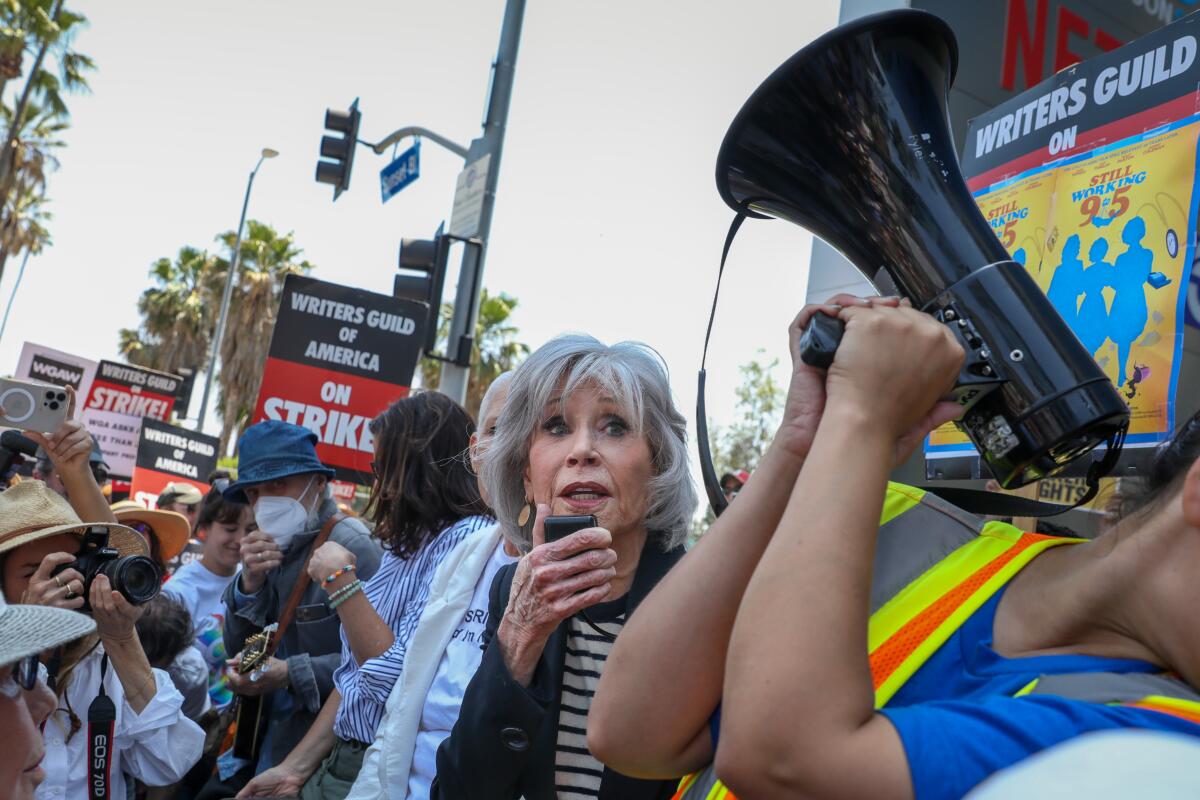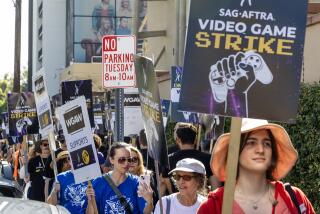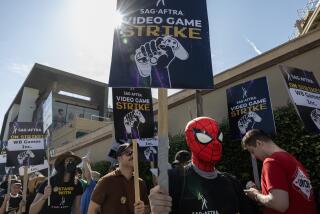SAG-AFTRA members may go on strike soon. Here are four reasons why

- Share via
Hollywood’s actors could be on the verge of striking over their main film and TV contract for the first time in 43 years.
SAG-AFTRA members have already voted overwhelmingly to authorize a strike if their leaders can’t secure a new film and TV contract to replace one that expires midnight Friday.
It would mark the first time since 1960 that the major studios would face simultaneous strikes by actors and writers, who walked out May 2 in a dispute fueled mainly by streaming pay.
SAG-AFTRA has approved a deal from the studios to end its historic strike. The actors were on strike for more than 100 days.
SAG-AFTRA, Hollywood’s largest union which represents about 160,000 performers, has been in negotiations with the Alliance of Motion Picture and Television Producers, which bargains on behalf of the studios, since June 7.
Despite tensions, guild leaders said Saturday that talks with the studios have been “extremely productive.” But key differences remain, and the union is still under heavy pressure from guild members to hold the line in bargaining.
That was underscored this week when more than 300 actors signed a letter saying they are prepared to strike if the union can’t secure a “transformative deal.”
Although a strike could happen as early as Saturday, sources say the sides could still agree to extend talks to allow more time to reach a deal.
Here are four key issues that the two sides are haggling over.
Members of SAG-AFTRA voted by a wide margin to give their leaders authority to call a strike even before negotiations have begun with the major studios.
Streaming residuals and how to calculate them
Like writers, actors have long depended on residuals — the fees they collect when TV shows and movies are reaired after their initial release — to sustain them between jobs.
But the streaming era has upended the old payment model that existed when broadcast networks dominated. Today, streamers pay residuals based on a fixed formula that does not reflect the international popularity of a show, nor is it pegged to viewership metrics.
Despite the proliferation of new shows across multiple streaming platforms, actors maintain that these changes have eroded their overall compensation.
“While new business models mean that more and more SAG-AFTRA content is monetized around the globe, residuals payments are failing to reflect the economic value of this exhibition,” the union told members recently. “SAG-AFTRA is committed to ensuring residual payments both reflect the economic value of our members’ contribution, and serve as a meaningful source of performer earnings.”
One of the chief sticking points in negotiations involves what metrics are used to measure how well a show performs on a streaming platform — and who tracks the data. Critics have long complained about a lack of transparency surrounding the performance of shows on Netflix and other streaming platforms.
SAG-AFTRA wants royalties to reflect the success of the most watched shows. And the union has proposed using a third-party provider such as Parrot Analytics to track the data in much the same way Nielsen ratings are used, said a source close to the negotiation who was not authorized to comment.
But the studios have balked at the proposal, arguing viewership doesn’t necessarily translate to more subscriptions and that streaming has offered actors more roles as it led to a boom in new TV shows. What’s more, they argued, not all the platforms are profitable.
The cost of self-taping
Although actors share many of the same concerns as writers and directors, some issues are specific to their profession. Among those is the burden of self-taping auditions.
During the COVID-19 pandemic, there was a shift to have actors tape their own auditions from home. This practice has continued, much to the chagrin of performers who say self-taping has become both time-consuming and expensive, requiring them to learn too many pages of dialogue in short periods of time and saddling them with the cost of the audition process.
SAG-AFTRA has called the trend “a massive, daily, uncompensated burden on the lives of performers.” The union is seeking rules and limits on the use of self-tape auditions.
Minimum pay
Actors are seeking increases in minimum pay to offset inflation and shifts in how television is made that they contend have made it harder for them to earn a living.
The move to streaming has led to shorter orders of series and longer breaks between productions, which is causing members to struggle financially, union officials say.
“With inflation and continued growth in streaming, we need a seismic realignment of our minimum pay,” more than 300 actors said in their letter to leaders Wednesday.
Artificial intelligence
All the major Hollywood unions have voiced concerns about the use and potential abuse of artificial intelligence.
SAG-AFTRA, in particular, has already described the technology as “a real and immediate threat” to the work of its members, citing AI’s ability to mimic actors’ voices, likenesses and performances.
The union said it wants to get an agreement over acceptable uses of the technology and secure protections against its misuse. It also wants to ensure consent and that members are compensated not only when AI is used to create new performances, but also when their work is used to program AI systems.
More to Read
Inside the business of entertainment
The Wide Shot brings you news, analysis and insights on everything from streaming wars to production — and what it all means for the future.
You may occasionally receive promotional content from the Los Angeles Times.













